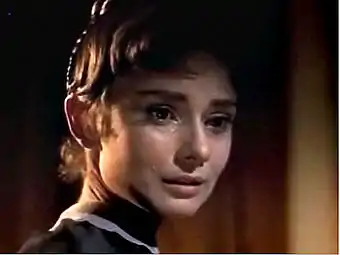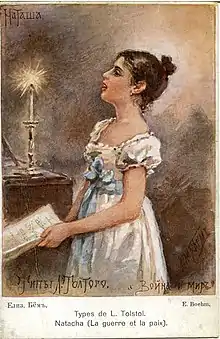Natasha Rostova
Countess Natalya "Natasha" Ilyinichna Rostova (/iːljiːˈniːtʃ.nɑːˈ roʊ.stoʊˈvɑː/; Russian: Наталья "Наташа" Ильинична Ростова, named Natasha Rostov in the Rosemary Edmonds version; born 1792, according to the book) is a central fictional character in Leo Tolstoy's 1869 novel War and Peace. She is the daughter of Ilya Rostov, a loving, kind, and generous nobleman. Natasha is based on both Tanya Behrs, Tolstoy's sister-in-law,[1] and Sophia Tolstaya (née Behrs), Tolstoy's wife.
| Natasha Rostova | |
|---|---|
| War and Peace character | |
 | |
| Created by | Leo Tolstoy |
| Portrayed by | Audrey Hepburn Ludmila Savelyeva Morag Hood Clémence Poésy Lily James Phillipa Soo Denée Benton Lauren Zakrin Shoba Narayan Erika Ikuta Bruna Guerin Anna Netrebko Ruzan Mantashyan |
| In-universe information | |
| Full name | Natalya Ilyinichna Rostova |
| Nickname |
|
| Gender | Female |
| Title | Countess |
| Family | Ilya Rostov (father) Natalia Rostova (mother) Vera Rostova (sister) Nikolai Rostov, Petya Rostov (brothers) Sonya Rostova (cousin) |
| Spouse | Pierre Bezukhov |
| Children |
|
| Nationality | Russian |
Biography

At the start of the novel in 1805, Natasha is a 13-year-old girl, the daughter of Count Ilya Rostov and Countess Natalya Rostova. She has fallen in love with young Prince Boris Drubetskoy, who lives with his mother Anna Mikhaylovna in the Rostov estate. She becomes close friends with Count Pierre Bezukhov, who frequently visits the Rostovs. When Boris leaves to pursue a career in the staff of General Mikhail Kutuzov, their friendship evaporates. At her first ball, Pierre introduces her to Prince Andrei Bolkonsky. They fall in love and become engaged, but Andrei's father objects to the match. He forces Andrei to postpone the marriage for a year, during which he goes on a tour of Europe and finds a tutor for his son. A visit to Andrei's father ends in a falling-out between Natasha and Princess Maria, Andrei's sister. During Andrei's absence, Prince Anatole Kuragin takes advantage of the situation by courting Natasha, even though he is already married. She succumbs to his charms and tries to elope with Kuragin. Although this is thwarted by Natasha's cousin Sonya, Natasha hastily writes to Princess Maria, breaking off the engagement. After her plan to elope is ruined, Natasha attempts suicide. She is rescued by the doctor before she dies. As Napoleon advances into Russia, the Rostovs are forced to evacuate their estate and retreat to their Moscow residence. When the Rostovs plan to evacuate Moscow, her parents use the carts for transportation of the wounded soldiers, and Natasha discovers that Andrei is among the wounded soldiers. She devotes all her time to nursing him.
After the French forces depart Moscow, Natasha again meets Andrei's sister Maria and together they nurse Andrei until he dies. They are reunited with Pierre, whose estranged wife Helene has died. Natasha and Pierre fall in love. Eventually, they marry and have four children.
Adaptations
The character of Natasha Rostova is difficult to portray on film or television because she ages from a 13-year-old girl in book one to a 28-year-old mother of four at the end of the novel. Several actresses have portrayed Natasha Rostova to critical acclaim.
In 1956, Audrey Hepburn was cast as Natasha in King Vidor's War and Peace. She was nominated for a BAFTA Award for best British actress and for a Golden Globe Award for best actress in a drama production. Moreover, Harlow Robinson writes that Hepburn "makes a visually compelling Natasha...".[2]
Other performances include those of Morag Hood in the 1972 BBC miniseries with Anthony Hopkins as Pierre,[3] Ludmila Savelyeva in Sergei Bondarchuk's adaptation,[4] Clémence Poésy in the 2007 miniseries[5] and Denée Benton (Phillipa Soo Off-Broadway) in the New York musical adaptation, Natasha, Pierre & The Great Comet of 1812, which received 12 Tony nominations in 2017.[6] In the 2016 BBC One six-part drama based on the novel, Lily James played Natasha Rostova.
Scholarly reception
The Encyclopedia of Literature remarks that Natasha "is undoubtedly Tolstoy's ideal woman,"[7] while the Academic American Encyclopedia describes her as "the embodiment of impulsiveness and spontaneity...".[8] The transformation of her character towards the end of the novel from a joyous, spirited 'waif-like' beauty into a plump, rather slatternly woman who is only interested in her husband and children has been criticized. Dorothea Barrett compares this to the description of a matronly Dinah Morris at the end of Adam Bede, which she calls 'inappropriate, almost humiliating'.[9]
See also
References
- Amy Mandelker (2004-05-31). "Leo and Sonya: Tolstoy's Courtship in Fiction and Fact". Oprah.com. Retrieved 2022-02-09.
- Harlow Robinson, Russians in Hollywood, Hollywood's Russians: Biography of an Image (UPNE, 2007), 163.
- The Annual Register; World Events: World Events (St. Martin's Press, 1973), 449.
- Kenneth White Munden, The American Film Institute Catalog of Motion Pictures Produced in the United States (University of California Press, 1971), 1191.
- "War and Peace". IMDB. Retrieved 1 January 2019.
- Paulson, Michael (May 3, 2017). "'Great Comet' Shines Bright". The New York Times.
- Joseph Twadell Shipley, Encyclopedia of Literature (Philosophical Library, 1946), 833.
- Academic American Encyclopedia (Aretê Pub. Co., 1980), 25.
- Barrett, Dorothea (1989). Vocation and Desire: George Eliot's Heroines - Dorothea Barrett - Google Books. ISBN 9780415056748. Retrieved 2019-01-01.
Further reading
- Daniel Lattin, "Natasha Rostova vs. Anna Karenina: A Comparison of Falls from Grace"
- Andrew Kaufman, Oprah's Book Club, "Finding Inspiration in Tolstoy's War and Peace".
- Valeria Sobol, Columbia University, "Reading the Invisible: The Mind, the Body and the Medical Examiner in Lev Tolstoy's Anna Karenina"
External links
- "Natasha Rostova (Character) from Voyna i mir (1967)," The Internet Movie Database